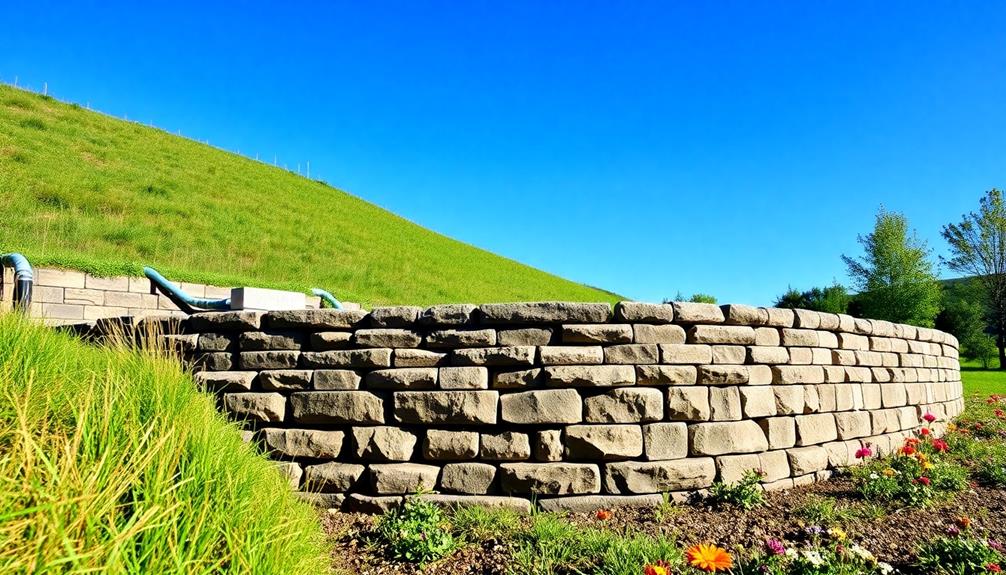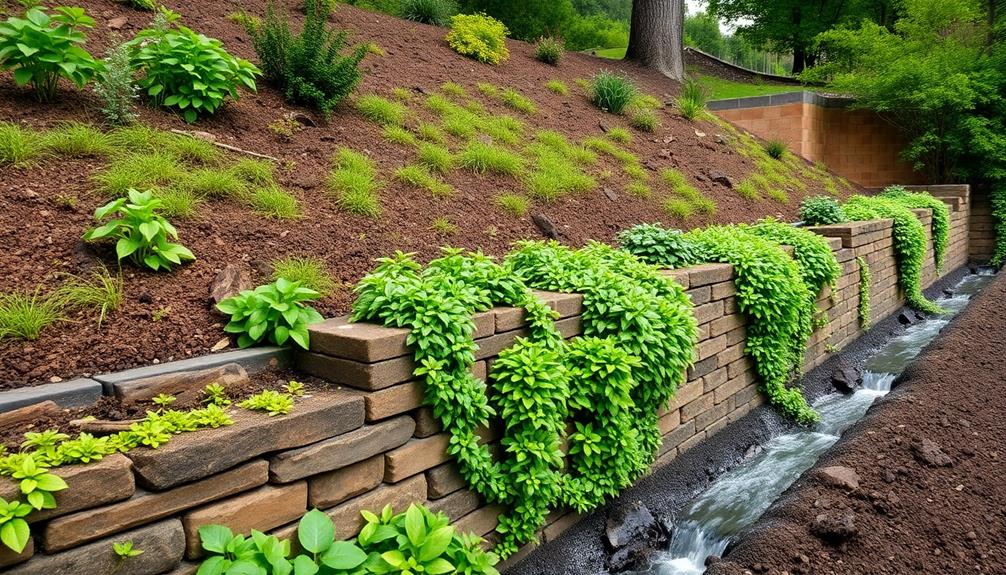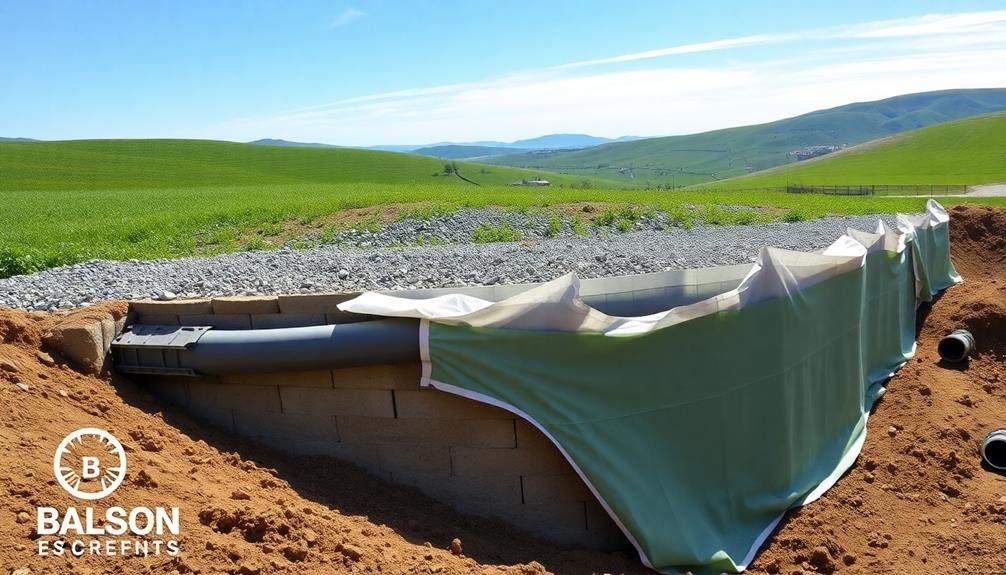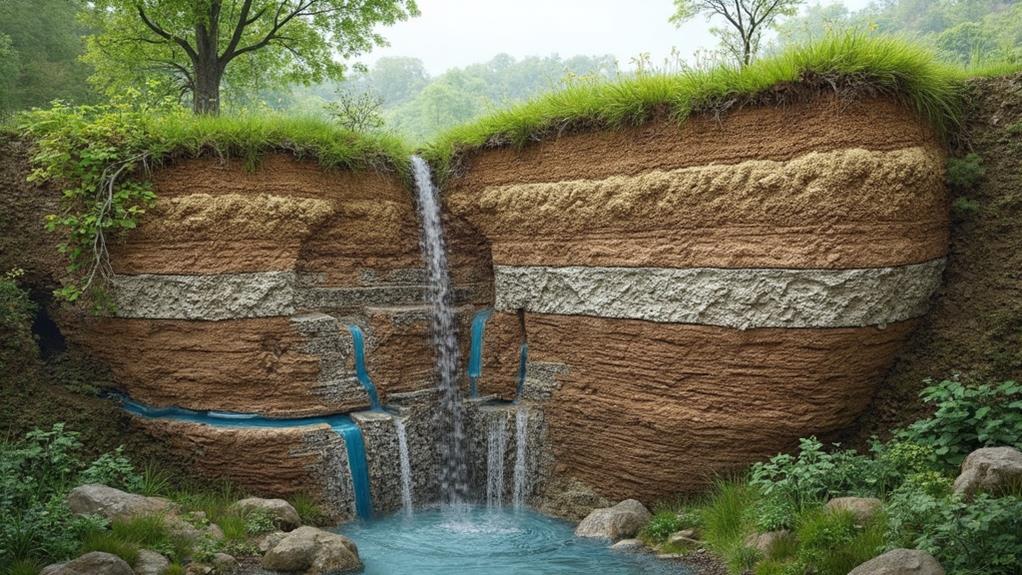Proper drainage is essential for retaining walls because it prevents water accumulation and reduces hydrostatic pressure, which are both critical to preserving structural integrity and preventing soil erosion. An effective drainage system safeguards against foundation shifts and water pooling, both of which can compromise the wall's stability and incur costly repairs. Implementing drainage solutions such as weep holes and perforated pipes enhances the wall's longevity by mitigating structural degradation and ensuring compliance with building codes. Additionally, well-integrated drainage complements the landscape design, creating aesthetically pleasing and functional spaces while safeguarding the surrounding environment from potential water damage. More insights await.
Table of Contents
ToggleWalls Contractor Highlights
- Proper drainage prevents water accumulation, reducing hydrostatic pressure on retaining walls and minimizing soil erosion.
- Effective drainage systems protect the structural integrity of the wall, ensuring long-term durability and compliance with building codes.
- Drainage integration stabilizes retaining walls by preventing water-induced shifting, settling, or foundation damage.
- Proper drainage enhances landscape design by controlling water flow and creating visually appealing, usable spaces.
- By preventing soil erosion and hydrostatic pressure buildup, drainage systems reduce maintenance and repair costs for retaining walls.
What Defines Retaining Walls?

Retaining walls are defined by their key structural features, such as their capacity to withstand lateral soil pressure and prevent erosion, which are influenced by the choice of materials—ranging from concrete and stone to wood and steel—and the design options that determine their aesthetic and functionality.
Integrating proper drainage into retaining wall construction guarantees effective erosion control, which is essential for enhancing the wall's longevity. These walls serve a critical function in landscape architecture and civil engineering by enabling grade changes and creating usable space in areas with challenging topography, thereby offering both structural support and visual appeal.
Their purpose extends beyond mere support, as they contribute to effective land and water management when integrated with proper drainage systems, improving their durability and performance.
Key Structural Features
A well-designed retaining wall is characterized by several key structural features that guarantee its stability and functionality. These elements are indispensable not only for the structural integrity of the wall but also for ensuring that it fulfills its purpose effectively, especially under the pressures exerted by the soil and external environmental factors. Each feature plays a pivotal role in safeguarding the wall from potential threats such as soil erosion, water accumulation, and unexpected ground movements, which can compromise the wall's durability and safety.
Key structural features of retaining walls include:
- Drainage Systems: Proper drainage is imperative to prevent water buildup behind the wall, which can increase pressure and lead to structural failure.
- Foundation Support: A solid foundation is essential to provide the necessary support and prevent shifting or settling over time.
- Wall Height and Thickness: These dimensions must be carefully calculated to withstand the specific soil conditions and external stresses.
- Reinforcement Elements: Incorporating materials such as steel bars or geogrid can enhance the wall's strength and resistance.
- Backfill Material: The selection of appropriate backfill material is indispensable for ensuring adequate drainage and stability of the wall.
Materials and Design Options
While key structural features guarantee stability, the choice of materials and design options fundamentally defines retaining walls. These elements not only enhance the structural integrity, but they also harmonize with the surrounding environment, fostering a sense of belonging. Materials such as concrete, stone, brick, and timber each have unique characteristics that influence both aesthetics and function. Concrete, known for its durability and versatility, allows for a wide range of design possibilities, including textured finishes and colored pigments. Stone, offering natural elegance, integrates seamlessly with landscapes, evoking a timeless appeal.
Effective design options, including tiered formations or curved structures, contribute to both visual interest and functionality. Tiered walls, for instance, can transform sloped terrains into usable space, providing functional depth and creating intimate garden enclaves. Curved walls, on the other hand, invite gentle shifts and can elegantly contour around existing landscape features, underscoring a thoughtful approach to design.
These choices are pivotal, not merely for aesthetic appeal, but for ensuring that the retaining wall meshes with existing outdoor spaces. Ultimately, informed decisions regarding materials and designs lead to sustainable enhancements, reinforcing both the land and the community's engagement with it.
Function and Purpose
Defining the fundamental purpose of retaining walls is essential in understanding their role in landscape architecture. These structures serve as pivotal elements in preventing soil erosion, managing water flow, and creating usable land on varied terrains. By holding back earth or water, retaining walls facilitate the alteration of natural land sloping, thus enabling construction and landscaping projects in spaces which might otherwise be unusable. Their robust designs help to stabilize steep gradients, protect infrastructure, and provide aesthetic enhancements to gardens and commercial properties alike.
Retaining walls offer more than just functional support; they also help define spaces, contributing to a sense of belonging and communal identity through well-integrated landscape designs. Their construction, when combined with proper drainage solutions, guarantees longevity and resilience, embodying a balance between practicality and visual appeal.
Crucially, retaining walls are defined by a combination of key features and functions:
- Structural Integrity: Essential for maintaining soil stability over time.
- Aesthetic Value: Enhancing the visual appeal of spaces.
- Erosion Control: Preventing the degradation of landscapes.
- Water Management: Facilitating controlled water flow, mitigating flood risks.
- Space Optimization: Creating usable land in previously inaccessible areas.
In landscape architecture, achieving a harmony between nature and human ingenuity often begins with a well-executed retaining wall.
Benefits

Implementing proper drainage systems for retaining walls is indispensable in preventing water accumulation, which not only boosts the durability of the walls but also safeguards their structural stability. By effectively channeling water away, these systems dramatically reduce soil erosion, thereby maintaining the integrity of the surrounding landscape.
Drainage systems play an essential role in retaining wall design, as they help guarantee compliance with local building codes and collaborate with clients to achieve desired aesthetic. This thorough drainage approach ensures that retaining walls remain a long-lasting and robust solution for managing varying terrain and protecting property.
Prevents Water Accumulation
Proper drainage is essential in maintaining the integrity and longevity of retaining walls by preventing water accumulation. When water is allowed to collect behind a retaining wall, it exerts hydrostatic pressure that can destabilize the structure, leading to potential failure. The accumulation of water not only undermines the wall's foundation but can also result in soil erosion and subsequent settlement issues in the surrounding landscape. Retaining walls, consequently, must be designed and constructed with effective drainage systems that efficiently redirect water away from the soil behind them.
Implementing proper drainage for retaining walls guarantees several key benefits:
- Prevention of Hydrostatic Pressure: Effective drainage channels reduce the pressure exerted by water on the wall, considerably lowering the risk of structural compromise.
- Protection Against Soil Erosion: With adequate drainage, the risk of soil erosion is minimized, preserving the landscape's overall stability.
- Minimized Foundation Shifts: Proper water management prevents ground saturation, reducing foundation shifts that could endanger nearby structures.
- Enhanced Landscape Aesthetics: By preventing water pooling, well-drained retaining walls help maintain the visual appeal of a property.
- Cost Efficiency: Proactively addressing drainage minimizes long-term repair costs associated with water damage.
Enhances Wall Longevity
A well-executed drainage system holds paramount importance not only for preventing immediate structural issues but also for enhancing the longevity of retaining walls. Proper drainage guarantees that water is efficiently channeled away from the wall, drastically reducing the overall pressure exerted on the structure over time.
As water can be a formidable contributor to structural degradation, managing its flow effectively mitigates risks associated with hydrostatic pressure, which can gradually compromise the integrity of the wall.
In the pursuit of constructing durable retaining walls, the integration of drainage solutions such as weep holes, drainage pipes, and permeable backfill material is essential. These elements function collectively to minimize moisture retention and pressure buildup, thereby decreasing the potential for cracks and displacements.
Over time, the cumulative benefit of reduced strain can be compelling, safeguarding the wall's foundational stability and aesthetics.
Reduces Soil Erosion
Effective drainage systems in retaining walls play an essential role in reducing soil erosion, a common environmental issue that can lead to significant structural damage if not addressed. Soil erosion occurs when water accumulates and exerts pressure on these structures, often leading to the slow degradation of land stability and presenting challenges that resonate with communities living in susceptible areas. Proper drainage mitigates these risks by directing water away from the wall's base, reducing hydrostatic pressure, and preserving the surrounding landscape's integrity.
For a community that values cohesion and sustainability, understanding the benefits of strategic drainage systems in retaining walls can unite efforts towards environmental conservation. The adoption of effective drainage systems yields numerous advantages, which can be summarized as follows:
- Minimizes potential for structural damage stemming from prolonged water exposure.
- Preserves the natural landscape, thereby supporting biodiversity and preventing habitat loss.
- Promotes groundwater recharge, contributing to the ecological balance within the area.
- Reduces maintenance costs associated with frequent repairs or reconstruction of eroded structures.
- Enhances community safety by preventing landslides or soil collapse in residential or urban areas.
This knowledge serves as a foundation for informed decision-making and community engagement in advocating for such sustainable practices.
Improves Structural Stability
In addition to mitigating soil erosion, strategic drainage systems in retaining walls considerably enhance structural stability. Constructed with the foresight of drainage, these systems play a pivotal role in reducing hydrostatic pressure—the force exerted by water stored behind the wall. Without proper drainage, water accumulation intensifies this pressure, potentially leading to wall failure, which is a grave risk for structures built to last.
By installing adequately-designed drainage paths, such as weep holes or perforated pipes, water is directed away from the retaining wall, alleviating undue stress and diminishing the risk of structural compromise.
The integration of drainage solutions also serves to prevent the saturation of backfill material. When the soil behind a wall becomes excessively moist, its weight increases dramatically, further taxing the stability of the wall. Conversely, saturated soil might freeze in colder climates, leading to frost heave that can displace or crack the structure.
Employing drainage becomes an essential step in maintaining the integrity and longevity of retaining walls, aligning the natural efficacy of the wall's load-bearing abilities with a network that harnesses and redirects environmental forces. Such a measure contributes to community safety and satisfaction by fostering enduring, stable landscapes.
Contractor Installation Recommendations

Proper installation of retaining wall drainage systems is critical to guarantee structural longevity and efficacy, hence contractors must be equipped with essential installation techniques, awareness of diverse drainage system options, and strategies to avoid common mistakes. Proper alignment and compaction, selection of suitable materials, and understanding the potential pitfalls are fundamental components that guide contractors in achieving optimal performance. The table below outlines key considerations:
| Essential Techniques | Drainage Options | Common Mistakes to Avoid |
|---|---|---|
| Adequate Compaction | Perforated Pipe Systems | Inadequate Backfill Material |
| Slope Considerations | Gravel and Geotextile | Improper Water Proofing |
| Material Selection | French Drains | Lack of Maintenance |
Essential Installation Techniques
A myriad of factors must be considered when installing retaining walls to safeguard ideal drainage and structural longevity. Solid installation practices are the foundation upon which an effective drainage plan is built, securing the wall's strength and durability against soil and water pressure.
A well-executed retaining wall seamlessly integrates with its surroundings, fostering a sense of harmony and belonging within the landscape. Precise attention to materials, layout, and soil conditions establishes the framework necessary to manage water flow effectively, shielding both the structural integrity and the adjacent environment.
Key installation techniques include:
- Optimal Foundation Preparation: Excavate to the appropriate depth and stabilize a stable, leveled base layer, critical for the wall's stability.
- Use of Quality Materials: Select the right type of stones, blocks, or concrete, knowing that their strength directly impacts the wall's robustness.
- Backfill Components: Employ properly graded gravel or crushed stone to promote water passage while providing lateral support.
- Drainage Pipes: Install perforated pipes at the base to facilitate consistent water removal from behind the structure.
- Compaction Techniques: Stabilize all fill materials are compacted thoroughly, reducing voids and minimizing settlement over time.
Adhering to these core principles supports a sustainable, efficient drainage solution that safeguards your retaining wall stands the test of time.
Drainage System Options
Various drainage system options are available to enhance the functionality of retaining walls, each designed to address specific site needs and challenges. Perforated pipe systems, one prevalent choice, efficiently transport water away from the wall's base, mitigating hydrostatic pressure—a leading cause of structural failure. These systems are often complemented by geotextile fabric, guaranteeing that soil does not clog the pipes, thereby prolonging their effectiveness. Contractors may recommend placing these pipes below the wall footing, sloping them towards an outlet to facilitate ideal water discharge.
In addition to pipe systems, gravel backfill stands as a robust choice, capable of providing exceptional drainage properties. When installed properly, it forms a semi-permeable barrier, guiding water through its interstices while preventing soil migration. This method offers versatility, as contractors can adapt the gravel's depth and type to suit varying soil conditions.
Weep holes, small, evenly spaced openings at wall joints, also serve as an effective drainage measure. Their role in alleviating internal water pressure cannot be understated, as they provide a direct path for trapped moisture to escape, thus preserving the wall's integrity.
Understanding these options guarantees not only the longevity of retaining walls but also strengthens the bond between infrastructure and its environment.
Avoiding Common Mistakes
While selecting the appropriate drainage solutions is essential for retaining wall functionality, ensuring their correct installation is equally important to avoid common pitfalls. Contractors play a key role in this process; mistakes can lead to structural failure, water damage, and additional costs. For those in pursuit of excellence and community trust, it is necessary to adhere to best practices, thereby guaranteeing lasting and effective retaining walls.
In the domain of retaining wall construction, avoid these frequent missteps:
- Improper Drainage Layer: Failing to lay a proper drainage layer behind the wall can result in water buildup, compromising stability.
- Insufficient Backfill Compaction: Loose or inadequately compacted backfill material undermines wall integrity, making it susceptible to shifting.
- Ignoring Slope Considerations: Not accounting for slope effects when installing drainage could hinder water flow and increase hydrostatic pressure.
- Inadequate Outlet Pipes: Poorly designed or placed outlet pipes can obstruct water egress, leading to moisture retention and potential structural failure.
- Overlooking Regular Maintenance: Neglecting routine inspections and maintenance can lead to undetected drainage issues, ultimately affecting wall health.
Walls Contractor FAQ
How Does Poor Drainage Affect the Structural Integrity of Retaining Walls?
Poor drainage leads to water accumulation behind retaining walls, increasing hydrostatic pressure and causing soil erosion. This compromises structural integrity, potentially leading to wall displacement or failure, highlighting the importance of community-driven solutions in engineering resilient landscapes.
What Materials Are Best for Ensuring Proper Drainage Behind Retaining Walls?
To guarantee proper drainage behind retaining walls, materials such as gravel, geotextile fabric, and perforated pipes are recommended. These components help prevent water accumulation, thereby enhancing wall stability and contributing to a secure, long-lasting community infrastructure.
How Can I Identify Drainage Issues in My Existing Retaining Wall?
To identify drainage issues in an existing retaining wall, look for signs of water pooling, soil erosion, wall bulging, or efflorescence. These indicators suggest inadequate water management, requiring immediate attention to maintain structural integrity and community safety.
What Regular Maintenance Is Needed to Maintain Proper Drainage for Retaining Walls?
To maintain proper drainage for retaining walls, regularly inspect and clear weep holes, guarantee drainage pipes are obstruction-free, and check for soil settlement. Performing these tasks helps prevent water accumulation, consequently ensuring structural integrity and community safety.
Are There Specific Climates Where Retaining Wall Drainage Is More Crucial?
Retaining wall drainage is particularly critical in regions with high rainfall or freeze-thaw cycles. These conditions can exacerbate water pressure and soil movement, potentially jeopardizing structural integrity and requiring careful attention to drainage solutions for community safety and cohesion.







